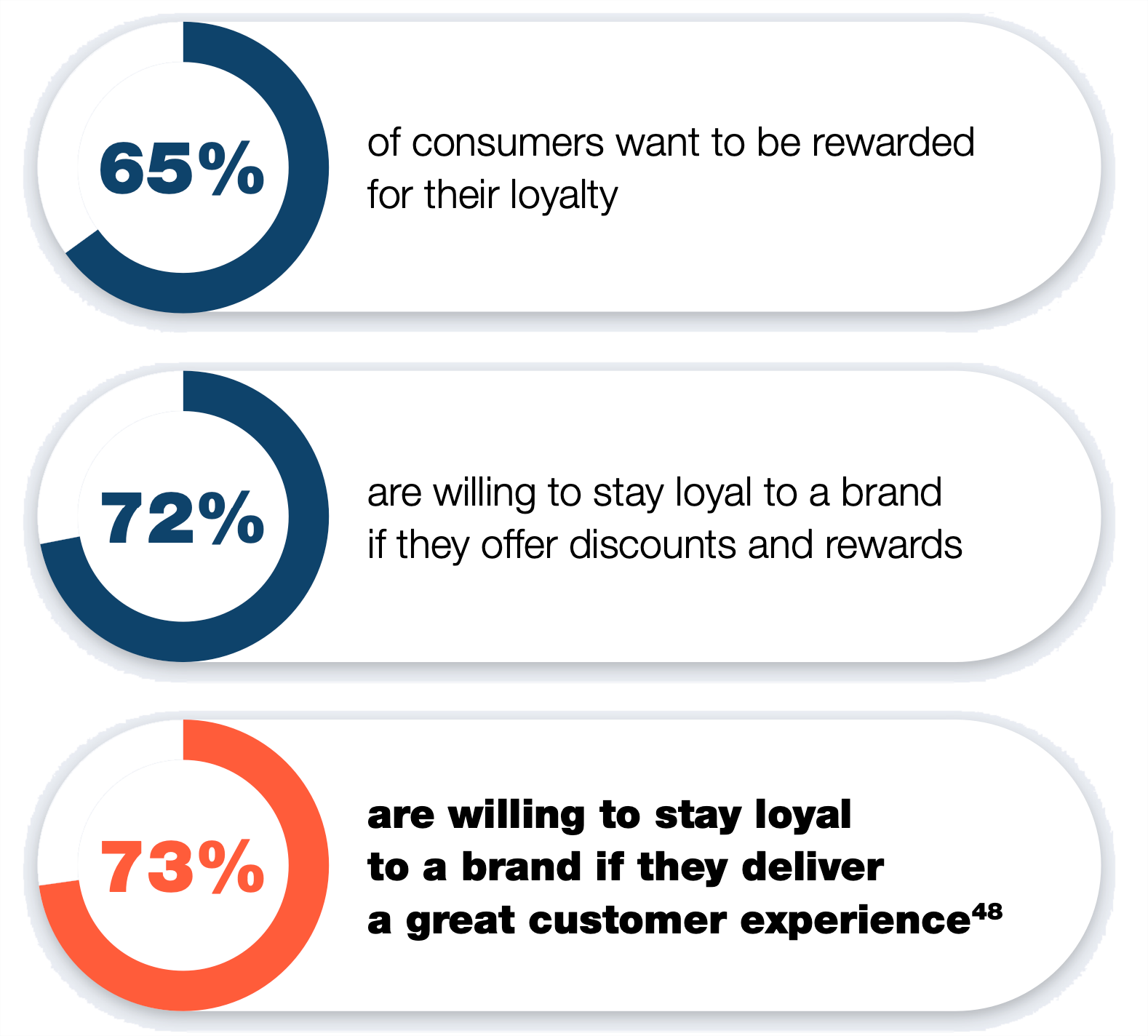Are You Ready for Marketing Made Better?
We can help you understand your customers, stay ahead of regulations, and grow your business.
Rising acquisition costs are driving businesses to focus on quality acquisition and retaining high-value customers.
For years, brands have prioritized growth at all costs. Across all sectors and markets, they’ve focused on acquiring and converting prospects using aggressive marketing tactics to maximize reach.
But acquiring new customers is getting harder and more expensive due to increased competition, market saturation, inflation, and tightening privacy regulations. McKinsey’s CMO survey reveals the average cost per click in 2022 was 20% higher than in 202143. And 61% of the business professionals we surveyed said customer acquisition has become more competitive in the last 12 to 18 months44.
What’s more, deepening economic concerns mean the focus of the investor community is swinging away from growth toward creating long-term value and driving profit. And, for many businesses, acquiring or converting customers is no longer the most efficient way to increase profitability.
Businesses are having to rethink their approachin this changing climate. Indeed, nearly half (45%) of the businesses we surveyed have changed their organization’s marketing priorities because of the economic downturn45. For many this means taking actions to acquire their ideal customer – rather than just any customer – and to retain and grow the high-value relationships they already have. A healthy acquisition and retention approach is no longer a nice-to-have, but a strategic imperative.
To succeed with this new focus, brands can harness the latest developments in AI to super-serve their existing customers with unique, highly personalized experiences. They can also integrate AI across their marketing operations, using predictive insights to acquire prospects with similar characteristics to their most valuable existing customers.
Case Study
Burberry is using big data and AI to create more seamless and personalized experiences for its most valuable customers across in-store and online channels. Burberry asks customers, who join its loyalty and rewards programs, to share their data through its mobile app. This data is used to deliver relevant recommendations for both in-app and in-store experiences.
In-store, sales assistants use tablets to access information about valuable customers, which informs buying suggestions. Employees can see a customer’s purchase history, their preferences and, if enabled, their social media footprint. They can use this data to deliver a more personalized experience, including recommending matching items or accessories based on previous purchases, or recommending items based on the customer’s online aesthetic.
In addition, all products in Burberry stores have their own unique RFID tag. When a customer stops at or picks up an item, the mobile app will send messages to the customer about the product. This may include where the product came from, its design aesthetic, or tips on how to style it.
This marrying of digital and physical engagement enables Burberry to provide an exceptional experience that makes its most important customers feel unique and valued.
Consumer perspective:
The economic landscape is leading people to be more judicious about their spending habits, which often means they’re not as loyal to brands as they once were. A McKinsey report46 reveals 80% of consumers are changing their shopping behavior by switching brands or retailers to find lower costs.
Our research reveals a similar picture, with 71% of the consumers we surveyed actively shopping around to get the best deal on a product or service, and 61% likely to switch to an alternative brand if it’s cheaper47.
These results are broadly similar across different age groups, although 16-34 year olds are the least likely to switch brands to get a better deal:

As a result of this switching behavior, the value of an existing customer has soared, and retaining customers has become pivotal to success. But it’s not as straightforward as simply offering customers the products they love at the right price.
We recently published a report about Gen Z which reveals a paradox. They appear both loyal and transient, with brand loyalty having less to do with the brand itself than with how that brand aligns with their personal values, as well as the opinions of the social influencers they trust. Brands need a deep understanding of the individual to acquire and retain a strong relationship.
Overall, today’s consumers are more connected, savvy,
and engaged with brands than ever before. In a world of endless choice, brands must work hard to build relationships with people and demonstrate that they add real value to their lives through relevant, personalized interactions in order to foster brand loyalty.
And people expect to be rewarded for that loyalty, whether financially or with exceptional experiences. Our survey revealed:

What’s more, consumers are becoming more aware of the value of sharing their data in exchange for exceptional experiences, according to the latest GDMA report on what consumers really think about data privacy. Brands that can harness the potential of data, predictive analytics, and AI will be strategically positioned to understand their most valuable customers and deliver unparalleled experiences that will ensure long-term engagement and satisfaction. They will also be well placed to acquire new customers who have a genuine affinity for their brand.
Customers are most likely to repurchase from a company if49:

They receive personalized loyalty rewards and programs

It is easy to sign up and create an account

They receive personalized customer support

They receive personalized products and services to meet their needs
Business perspective:
A number of the businesses we surveyed (43%) have reported a decline in customer loyalty over the last 12 to 18 months50. However, the way those businesses define and measure customer loyalty varies greatly.
Businesses define customer loyalty in different ways51:

Interestingly, the businesses we surveyed are more likely to measure brand loyalty by how engaged customers are, than by how much they spend or their longevity. This view contrasts somewhat with their marketing strategies, as more than half (58%) claim to have a marketing strategy specifically tailored to keep customers with the highest lifetime value (LTV), i.e., spend and longevity.52
Regardless of how brands define loyalty, it is evident that they recognize the importance of retaining high-value customers for long-term profitability and success. Yet, results from our survey show that few companies are taking concrete steps to drive loyalty and retention.
In fact, only 50% of the businesses we surveyed reward customers for their loyalty53, which means half of businesses surveyed do not. As we saw earlier, the majority of customers expect to be rewarded, and will stay loyal if they receive exceptional experiences or financial rewards, so this is something brands should consider.
Similarly, only 12% of the businesses we surveyed are currently using AI in their loyalty and retention tactics.54 This means most brands are missing out on a huge opportunity to make use of first-party data capabilities and AI to deliver unique and personalized experiences to engage their best customers.
In 2024, we expect this to change, as businesses increasingly invest in AI to super-serve their most valuable customers and acquire prospects with similar characteristics.
“For the regulated industries, AI can be a massively useful tool. For instance, insurance companies could use it to speed up underwriting decisions, claims handling, and fraud detection. Imagine using AI to make underwriting decisions in a fraction of the time, instead of taking 30 days to come to that decision, it takes 30 seconds. If managed correctly, that could mean a significant improvement in customer experience.”
Dana Goff, SVP Industry & Solution Strategy, Acxiom
Economic difficulties and diminishing returns from acquisition efforts may push businesses to slash marketing and CX investments, but this strategy could lead to dire long-term consequences. Consumer spending may be unpredictable, but McKinsey research55 shows consumers are still spending where it matters most to them. Which means if a customer isn’t purchasing from one brand they’re likely to be buying from a competitor.
The most successful businesses will prioritize investment in the customer experience. This will include using first-party data capabilities and AI to deliver unique and personalized experiences to their highest-value customers, and to make smarter marketing decisions that drive a healthy acquisition and retention strategy. We expect businesses to invest in the following tactics:
Applications of AI for retaining high‐value customers include:
Cross‐channel personalization: Businesses can use AI and predictive analytics to seamlessly connect their physical, in-app, and online channels, enabling digital browsing and transaction data to inform the offline experience and vice versa.
Dynamic segmentation: Businesses can supercharge their loyalty programs by allocating customers to different categories depending on their response to loyalty rewards or offers, with categories updated dynamically so interactions are always tailored to the latest customer engagement.
Predictive analytics: Brands can use AI-powered predictive analytics to identify which rewards or offers will resonate with individual customers, as well as which customers are likely to become disengaged, and then create personalized and engaging experiences that improve retention rates.
Immersive experiences: For retail brands, AI can personalize AR/VR try on experiences by suggesting products the customer may like based on their previous purchases, unique preferences, facial features, or aesthetic.
Applications of AI in acquisition efforts include:
Spend decisioning: Businesses can cut back on low-yield marketing spend and invest more where there’s greater potential for longer-term ROI.
Prospect segmentation: Businesses can streamline and enhance segmentation to identify their most and least valuable prospects at any given moment – without human bias.
Lookalike audiences: Using AI and their first-party data, brands can more accurately, and at scale and speed, identify their most valuable customers and then focus their acquisition efforts on third-party audience segments with similar characteristics.
Customer journey insight: Integrating ML with customer relationship management (CRM) systems can deliver customer journey insight to optimize acquisition strategies.
Personalized communications: Businesses can use generative-AI to execute highly personalized communications at scale, informed by a wealth of customer data.
“AI can also enable the use of new data sources to drive decisions. For example, in the financial services industry, the decision to give somebody a loan or a credit card has traditionally been through established credit data. Consider the possibility of using alternative data to make lending decisions for people with thin or no traditional credit data. This just hasn’t been possible before because we’re talking about millions and millions of transactions.”
Dana Goff, SVP Industry & Solution Strategy, Acxiom
Making it work:
Organizations that succeed in their efforts to acquire and retain high-value customers will be those that make the best use of a wide range of first- and third-party data sets and advanced analytics to build sophisticated and highly engaging customer experiences.
To ensure that their efforts are fruitful, businesses will need to prioritize investment in the following areas:
Data: Businesses will need a centralized system, such as a customer data platform (CDP), that pulls data from a variety of different sources (customer transactions, social media interactions, website traffic, etc.) to create a single, real-time customer view that powers AI models.
Expertise: Businesses need access to industry experts who can help them build, train, implement, manage, and optimize AI solutions. Whether internal or external, these experts can help with data collection, algorithm development, and model deployment.
Resources: Businesses need to ringfence the resources to implement AI solutions. This includes the time, money, and expertise needed to collect data, develop algorithms, and deploy models.
With the onus on brands to offer exceptional CX in exchange for continued loyalty, we expect to see a huge increase in the use of AI for loyalty and retention tactics, far beyond the 12% of brands that are currently using it.
To make the most of AI for customer retention, brands will need to prioritize building out and scaling robust first-party data. With this, we may see a renegotiation of the data value exchange, with people encouraged to share data with brands that can offer real value.
Coca-Cola is a great example of a brand that is scaling its first-party data by using AI to bring experiential content to its customers and engaging them beyond the transaction. On-pack QR codes for its new product, Y3000 Zero Sugar, allow consumers to access a custom AI camera that shows
what their reality could look like in future. Coca-Cola will use the first-party data generated by these interactions to segment customers and offer them tailored experiences to keep them engaged.
Ultimately, brands will use AI for strategic marketing activities and customer experiences that help them stay top of mind for high-value customers, reach the customers they’d love to have, and build resilience in the face of intensifying competition.
We can help you understand your customers, stay ahead of regulations, and grow your business.